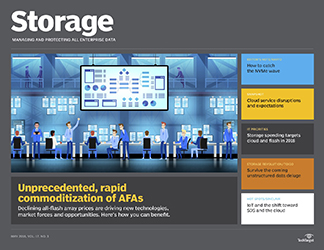PRO+ Premium Content/Storage
Access your Pro+ Content below.
NVMe technology is but a first step toward bigger things

This article is part of the Storage issue of May 2018, Vol. 17, No. 3
Nonvolatile memory express is probably on your radar, whether you're already using or considering buying flash storage. If you're talking to a storage array vendor, you're almost certainly hearing all about the new host controller interface and storage protocol. As vendors will tell you, nonvolatile memory express is an inevitable step in enterprise flash. They will also tell you their NVMe products provide the best performance and lowest latency, without disrupting the way you work. The part about performance and latency is true. NVMe's bandwidth and improved queuing make NVMe SSDs better performers than the SAS SSDs commonly used today. As far as which vendor's NVMe product is the best, that has little to do with NVMe itself, just as you don't generally judge flash arrays by comparing vendors' drives. NVMe technology is part of an evolving flash world, a step toward much more significant advances. You should look at NVMe as the beginning of a transition to storage-class memory (SCM). Switching to NVMe drives makes for a ...
Features in this issue
-
Three trends causing the rapid commoditization of AFA storage
Advancing technology and changing market forces have shifted the dynamics in the all-flash array market, opening it up to new challengers and benefiting customers.
-
Many enterprises aren't prepared for a cloud service outage
Some businesses have no idea what a cloud outage will cost them and who takes responsibility for restoring data and workloads, the customer or the cloud service provider.
Columns in this issue
-
NVMe technology is but a first step toward bigger things
NVMe is an inevitable move forward for flash technology that begins the transition to storage-class memory and will lead to even more significant storage advances.
-
Cohesity's hyper-converged secondary storage takes on data growth
An out-of-the-box secondary storage strategy to deal with the coming deluge of file and object data promises to overcome scalability, management and capacity limits of NAS.
